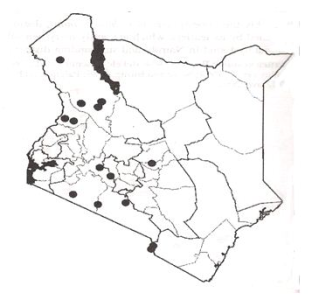Introduction
General Distribution:
 |
| Distribution of Acacia albida in Kenya |
| © Maundu P. and Bo Tengnas. (2005). Useful trees and shrubs for Kenya, World Agroforestry Centre. |
General Information about the Tree:
Biophysical Limits:
Altitude: -270 - 2700 m, Mean annual temperature: 18-30 deg. C, Mean annual rainfall: 250 - 1200 mm, Soil type: Coarse-textured well-drained alluvial soils. It tolerates seasonal waterlogging and salinity but cannot withstand heavy clayey soils. Does well in agro-ecological zones IV - VII (riverine).
Propagation and Tree Management
Products:
- Food: During the dry season, people eat the seeds and pods (eaten cooked or raw in times of famine by the Pokot and Turkana) and also pods may be used in flavouring.
- Fodder: The leaves and pods are palatable to domestic animals and an important source of protein for livestock in the dry season.
- Apiculture: For bee-keepers, it has the advantage of producing flowers at the end of the rains while most of the sahelian species flower just before or during the rains. It therefore becomes the main source of pollen and nectar at this time.
- Fuel: The plant stems are used as firewood. The calorific value is estimated at about 19.741 kJ/kg of dry wood. Charcoal yields are low (17%) of the biomass.
- Timber: The heartwood (specific gravity 0.56-0.71) is pale and creamy, brown sapwood slightly paler than the heartwood. The wood is susceptible to staining fungi and pinhole borer when green; therefore, it is left to soak for several months to remove sap and minimize attack by fungi, borers and termites. Even after the most careful seasoning, the boards tend to spring and twist one or two hours after they are sawn. The wood works fairly easily by hand, but a smooth finish is difficult to obtain. Care must be taken when nailing, bolting and joining. It is used to make utensils, canoes, furniture, boxes, drums and oil presses.
- Medicine: The use of bark and roots either externally or internally against respiratory infections, digestive disorders, malaria and other fevers is widespread. The bark can be used to clean teeth, as it is believed to contain fluorine; a bark extract is used for treating toothache in humans and eye infections in livestock.
- Fibre: its bark may be used for making strings.
- Dye: the bark can also be used for extraction of dye
Services
- Soil fertility: F. albida sheds its leaves in the rainy season; therefore, boosting the nutrient status of the soil for the new season's crops. The fact that the tree is leafless during the rainy season minimizes competition for sunlight with crops and protects them from birds until harvest time. It is recommended for integration with maize as an alternative to Leucaena leucocephala. In addition to improving soil fertility, this tree species has many other uses;
- Shade or shelter: F. albida is maintained and protected on farms to shade coffee and to provide shade for livestock in the dry season.
- Reclamation: The plant's spreading root system offers excellent protection to the banks of watercourses.
- Ornamental: A useful ornamental tree for gardens and avenues.
- Boundary/barrier/support: Branches lopped for fencing compounds and livestock enclosures.
- Windbreaks: the tree is also useful when it comes to shielding buildings and even weaker crops from strong winds.
Pests and Diseases
Ficus thoningii and Taphinanthus dodoneifolius are epiphytes that kill the plant through strangulation. Nematodes and insect pests include bruchid beetles, which attack the seeds, Kraussiana angulifera and Tylotropidius gracilipes (Orthoptera), which attack young plants, and Cypsotidia angulifera, C. mesonema and C. wollastoni (Lepidoptera), which attack the leaves.
Information Source Links
Maundu P. and Bo Tengnas. (2005). Useful trees and shrubs for Kenya, World Agroforestry Centre. www.worldagroforestrycentre.org
